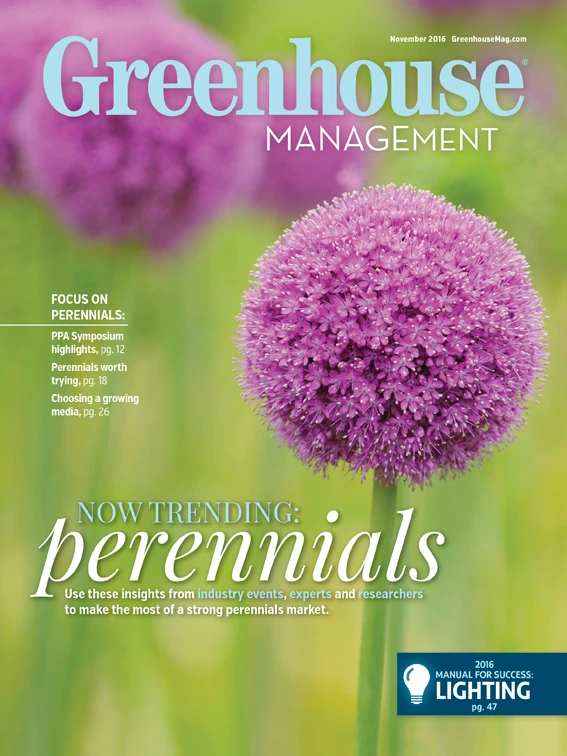
When discussing light and plant growth and development, spectra is an important aspect that must be considered. Other synonyms used to talk about light spectra include light quality or color. Photons, or particles of light, have frequencies, and the wavelengths of these frequencies are measured in nanometers. One of the reasons we are hearing more about light quality is that horticultural lighting, including high pressure sodium (HPS), metal halide and incandescent lamps include numerous spectra (broad-spectrum light). However, the recent explosion in light-emitting diode (LED) technology is resulting in narrow-spectrum lighting, which commonly only provides one to three spectra.
Light quality has wide-ranging effects on plant growth and development. Plant growth is directly affected by photosynthesis, so we are most interested in those spectra that affect photosynthesis for photosynthetic lighting. Plant development, or morphology, is affected by light spectra that may also be photosynthetic, as well as some spectra that do not directly affect photosynthesis.
Photosynthetically active radiation (PAR) is light between 400 and 700 nm, and these photons drive photosynthesis. There is variation in relative efficiencies, with respect to photosynthesis, across these wavelengths. Blue (~450 nm) and red (~630 nm) are more efficient than other PAR spectra; however, green, yellow and orange light are still effective photons for photosynthesis. Light quality can also affect the energy consumption for electrical lighting. For example, as the proportion of blue light increases in LEDs the energy consumption increases since blue is a higher-energy wavelength, which takes more energy to produce compared to red light.
In addition to photosynthesis, light quality also influences plant morphogenesis, including stem elongation, leaf expansion, flowering and dormancy. Phytochrome is a photoreceptor in plants that is involved in many of these processes, from seed germination to flowering. Red and far-red light both affect phytochrome, converting it to active and inactive forms, respectively. For greenhouse crop production, the ratio of red to far-red light is most important for effectively controlling flowering.
Incandescent bulbs have been the industry standard for low-intensity photoperiodic lighting and are very effective due to the ratio of red and far-red light emitted. Compact fluorescent bulbs can be used, however, since the amount of far-red light is lower they are not quite as effective. As a result, flowering for long day plants can be delayed when only fluorescent light is used. Recently LEDs have been adopted for use in low-intensity photoperiodic lighting. These LED bulbs are specifically designed to provide the appropriate amounts of red and far-red light and are just as effective as incandescent bulbs; however, be sure to double-check that the spectra included in any lamp designed for flowering includes red and far-red.
Blue light also affects morphology and, in some instances, blue light can influence plant morphology in a manner similar to red light. For instance, blue light can inhibit stem elongation and leaf expansion similar to increasing the proportion of red light to far-red light. This is one reason that blue can be included in photosynthetic lighting — in addition to being an efficient photosynthetic photon, it can also influence development. In narrow-spectra LED lighting, blue light is provided in different proportions to red light in lamps with fixed ratios of light quality. The desirable ratio will depend on the crop and growing environment.
Sponsored Content
Lawn and Landscape Marketing on a Budget
Digital marketing can feel overwhelming when you’re working with a limited budget. Websites, SEO, social media, and paid ads can quickly add up, but you don’t need to do everything to see results. By focusing on cost-effective strategies, you can still make a big impact without overspending.
Sponsored Content
Lawn and Landscape Marketing on a Budget
Digital marketing can feel overwhelming when you’re working with a limited budget. Websites, SEO, social media, and paid ads can quickly add up, but you don’t need to do everything to see results. By focusing on cost-effective strategies, you can still make a big impact without overspending.
Sponsored Content
Lawn and Landscape Marketing on a Budget
Digital marketing can feel overwhelming when you’re working with a limited budget. Websites, SEO, social media, and paid ads can quickly add up, but you don’t need to do everything to see results. By focusing on cost-effective strategies, you can still make a big impact without overspending.
Sponsored Content
Lawn and Landscape Marketing on a Budget
Digital marketing can feel overwhelming when you’re working with a limited budget. Websites, SEO, social media, and paid ads can quickly add up, but you don’t need to do everything to see results. By focusing on cost-effective strategies, you can still make a big impact without overspending.
Sponsored Content
Lawn and Landscape Marketing on a Budget
Digital marketing can feel overwhelming when you’re working with a limited budget. Websites, SEO, social media, and paid ads can quickly add up, but you don’t need to do everything to see results. By focusing on cost-effective strategies, you can still make a big impact without overspending.
Get curated news on YOUR industry.
Enter your email to receive our newsletters.
Explore the November 2016 Issue
Check out more from this issue and find your next story to read.
Latest from Greenhouse Management
- The Growth Industry Episode 3: Across the Pond with Neville Stein
- A nation of gardeners: A history of the British horticulture industry
- How Izel Native Plants is solving the native plant conundrum
- Trends: Proven Winners 2025 perennial survey shows strong demand
- Online registration opens for 2025 Farwest Show
- Cashing in with customization
- The Ball Seed Difference
- Lawsuit challenges new H-2 visa rules






